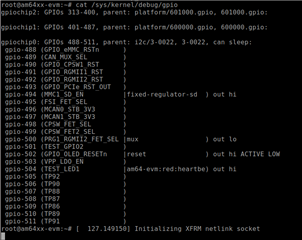Other Parts Discussed in Thread: SYSCONFIG, TPIC2810
Hi, I am trying to access the MCU GPIO peripherals (in the safety connector) from the Main domain on my TMDS64GPEVM. I am using the Linux processor sdk 7.3 and the updated device tree files from https://git.ti.com/cgit/ti-linux-kernel/ti-linux-kernel/tree/arch/arm64/boot/dts/ti?h=ti-linux-5.10.y .
I have generated the pinmux for these peripherals from the Sysconfig tool, but I am not sure how the MCU GPIO's get translated to the the bank/chip number when used in the Main domain. By default I could see the 2 main gpio banks and 1 that is created in one of the i2c.

I have updated the mcu_gpio status from "reserved" to "okay" and I am looking for the pin mapping so that I can test those gpios.
Based on this FAQ https://e2e.ti.com/support/processors-group/processors/f/processors-forum/948888/faq-ccs-tda4vm-tda4-how-do-i-determine-the-gpio-number-within-linux-for-a-pin-within-the-schematic I can see that the soc pin number + gpiochip offset can be used to find the gpio pin. Could you share as to how I can find the correct pin number in case of MCU pins ?



